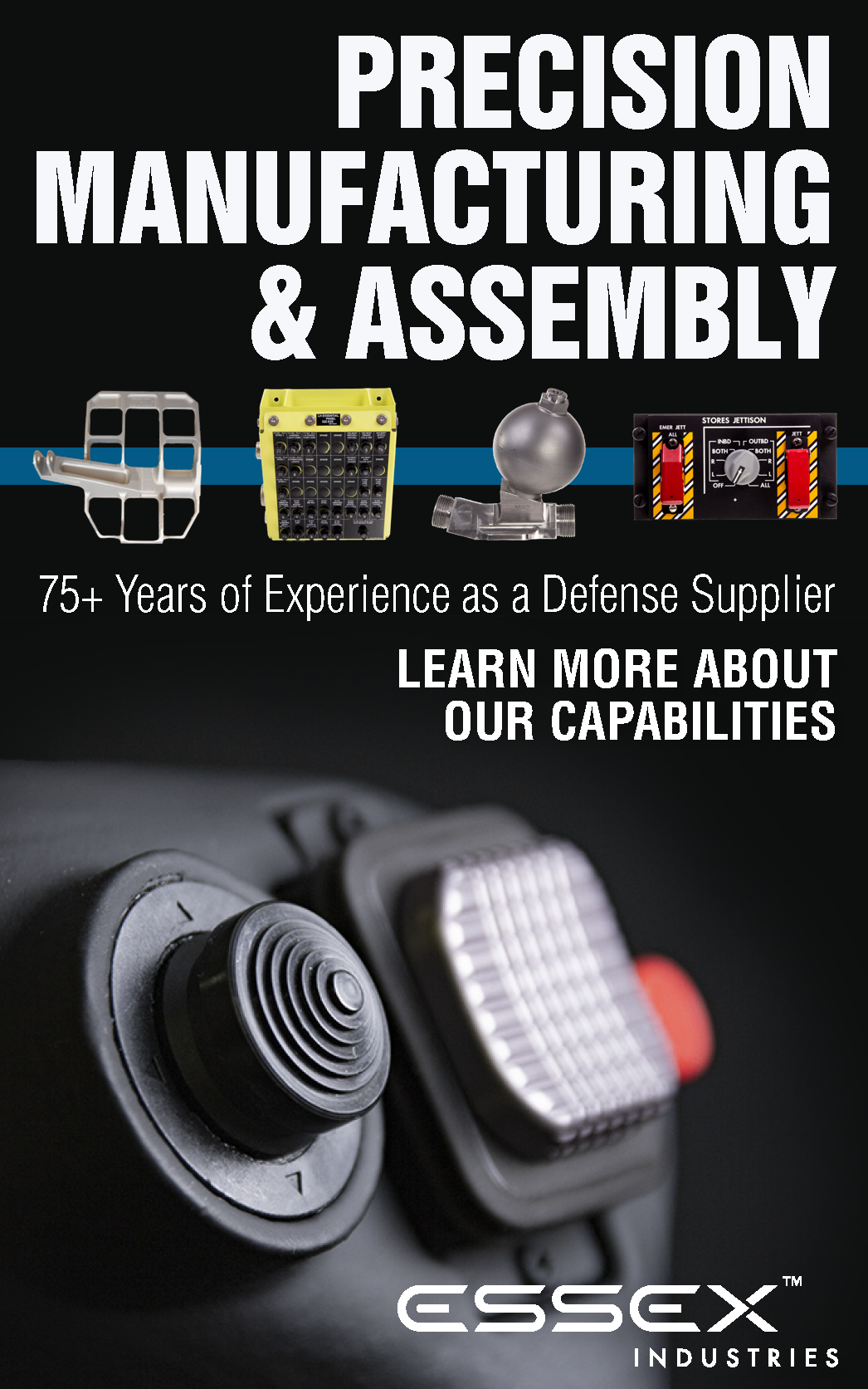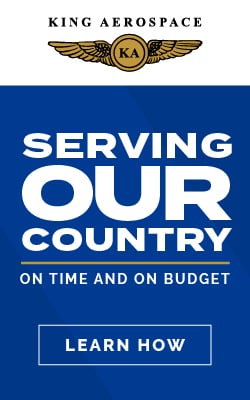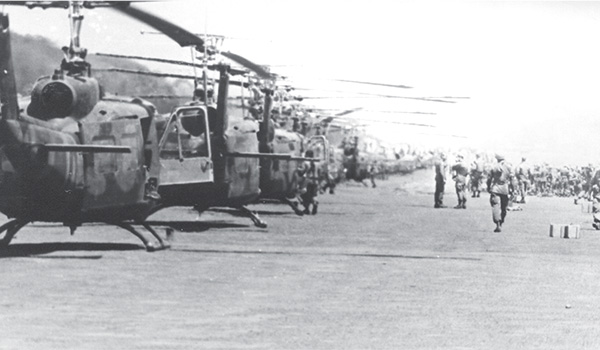
By Lieutenant General Harry W. O. Kinnard, Ret.: This decade was the worst of times; it was the best of times. Worst in its preoccupation with a war which cruelly tried and divided our country – a war which asked our Military to fight under unwinnable ground rules, subjected to a new and totally different level of news media scrutiny, and with least inconvenience to the American people. Best because, in it, Army Aviation ended its dependency on the Air Force and Navy, began to show its true promise, and moved from a walk to a full gallop.

Helicopters from the 145th Combat Aviation Battalion, 12th Combat Aviation Group prepare for takeoff at Trai Bai Vietnam, Feb. 22, 1967 as part of the 249 helicopter armada committed in support of Junction City, the largest air assault ever conducted. / U.S. ARMY PHOTO BY MAJ R. DON MASTERS, II 1ST AVN. BDE.
Building on the momentum from the two preceding decades, Army Aviation from 1963 to 1972 advanced in great depth, and on a very broad front. A few statistics are illuminating:
From 1963 to 1972, Army aviators increased from about 7,300 (about 2,000 were warrant officers) to about 26,000, and enlisted aviation specialists grew from about 20,000 to about 120,000. Annual output of new Army aviators, about 950 in 1963, inched up to about 1,300 by 1965, when budget cuts forced it back to about 1,100. At that level, aircraft production far outstripped available aviators, causing a hiatus of about nine months in deployments. Then output was increased, by adding Hunter Army Airfield to the “schoolhouse”, and reached a high of 7,200 in 1969. Moreover, new aviators graduated with increasingly greater proficiency in instrument flight and tactical flying.
Army aircraft, worldwide, jumped from 6,272 in 1962 to a peak of 12,652 in 1970, and the percentage that were helicopters rose, from about 49%, to almost 82%. An astonishing total of 14,901 aircraft was produced in these ten years, almost all turbine powered. We “got a handle’’ on safety in this decade, developed a system to accurately track what we were doing to ourselves, and took corrective actions, like crashworthy fuel cells. Major accidents per 100,000 flying hours dropped from 27.28 in 1963 to 10.82 in 1972. How the Army initiated and developed the massive, complex logistics to support this mushroom growth in Army Aviation is a story in its own right, but one which must go untold in this brief article.1
The Call of Vietnam
All this fast paced expansion was, of course, in response to the increasingly powerful pull from Vietnam for more, and better, Army aircraft. This strong pull, coupled with a powerful push from the CONUS, thrust Army Aviation into “orbital escape velocity” and it soared into a Golden Age. So much happened, both in CONUS and Vietnam, as to preclude even a listing of events in this article; it therefore covers only the testing of the 11th Air Assault Division, and a bit about airmobility in Vietnam.2

Seen from the air, helicopters from the 145th Combat Aviation Battalion, 12th Combat Aviation Group prepare for takeoff at Trai Bai Vietnam, Feb. 22, 1967 as part of the 249 helicopter armada committed in support of Junction City, the largest air assault ever conducted. / U.S. ARMY PHOTO BY MAJ R. DON MASTERS, II 1ST AVN. BDE.
Nowhere was progress in air mobility greater, or more closely watched (by friend and foe alike), than at Ft. Benning, GA, where the 11th Air Assault Division, and attached 10th Air Transport Brigade went through their paces, after activation in February 1963. Only these two units, of the five types recommended by the Howze
Board, were approved by the Army for testing.3
The tests were to be progressive; from a battalion combat team to a reinforced Division.4 A common misconception is that testing stressed low intensity conflict. Not so; if anything, there was slightly more emphasis on nuclear warfare, but testing placed essentially equal stress on all intensities.
As the first Army units in our country (and the world) to use aircraft as their primary means of operating, it was a whole new ball game. Even my directive, from Army Chief of Staff Wheeler, was refreshingly different. “Harry,” he had said, “I want you to determine how far and how fast the Army can go, and should go, in embracing Air Mobility.” I resolved to keep alive the spirit, and the implied freedom of that marvelous, mission type order, and pass it on, undiluted, to every person in our endeavor. Accordingly, everyone was urged to unfetter his mind and think in new, innovative ways to make airmobility the best it could be. We coined the word “imaginuity” to emphasize innovation, imagination and initiative, and established an “idea center” where ideas, however seemingly radical, were analyzed (and frequently put into practice). Industry was briefed on our needs, and their help invited. The response was immediate, continuous and most helpful.
Airmobility: A Definition
Brainstorming was the order of the day. Needing a simple definition of “Airmobility”, we deduced that, for us, it meant using Army aircraft whenever and however they improved our Army’s ability to fight. Examining our mission from General Wheeler, we concluded our primary job was providing the Army a valid basis for judging the concept of Air Mobility, rather than performing a Go/No-Go test on the Air Assault Division, as hastily conceived by the Howze Board. So, it was important to improve that original organization by repetitive tests aimed at finding its faults, correcting them, as best we could, and testing again, and again. We felt the resulting, improved Air Assault Division would offer a valid vehicle for judging the worth of Air Mobility.
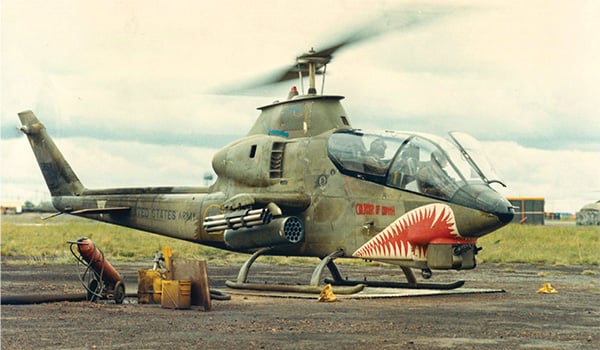
An AH-1 Cobra gunship preparing to depart on a mission in Vietnam circa 1969. / U.S. ARMY FILE PHOTO
Fixing faults, found in testing, implied development, as well as testing. We felt this repetitive test/development cycle should include equipment, doctrine, techniques, tactics and the organizations themselves. As an all-inclusive matrix, we used the five functions of combat (mobility, firepower, intelligence, command/control/communications and logistics).
An obvious starting point was a drastic reduction in the Divisions’ size and weight. I decreed that, “If we can’t sling load it on a Hook (CH-47), we’re better off without it.” We converted our Signal Battalion entirely to 1/4 ton trucks and trailers, sectionalized Engineer equipment so the largest piece could be slung by a Hook, and replaced huge Maintenance vans with light, slingable shelters, and so on, taking tons and tons of weight and much bulk out of our units. We became far lighter, and more air transportable than any Army Division, which is as it should be.
Thinking light didn’t end with equipment; we stripped to bare bones the personal load of our infantrymen to make them the fresh, alert, fast stepping fighters they should be. This meant a dedication always to get their extra equipment to them when needed; with our helicopters, we did just that.
Another obvious candidate for improvement was “forward basing”, a must for true air mobility. This involved basing our more than 400 helicopters on field helipads rather than airfields, developing forward refueling, and, above all, operating that way habitually.
Flight Requirements
On the flying side, astonishingly, when we were activated, formation flying was prohibited by Army regulations, except under most unusual circumstances. We felt formation flying was vital, obtained permission, and used it to the fullest. We also obtained relaxation in aviation weather minimums, and strove to become ‘’all weather’’ by stressing instrument flying, by adding GCA Radars to our equipment and by looking at weather as “micro weather” – the idea that because weather is seldom equally bad over the entire area of operations of an Air Assault Division, local commanders must make minute by minute, local, flight decisions. We also stressed night operations, did much night training and improvised lights which could be seen only by the aircraft in formation. We worked hard to perfect Nap of the Earth flying, believing it crucial in high intensity combat. For all the aviation units, as well as all the other units, the name of the game was teamwork; first, last and always.
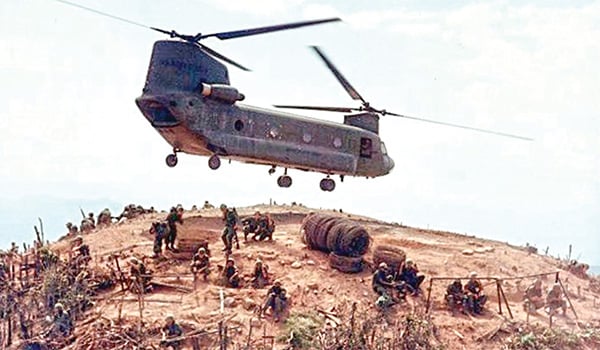
A CH-47 Chinook helicopter resupplies a firebase in the Cay Giep Mountains, Vietnam, 1967. / U.S. ARMY FILE PHOTO
Putting our infantrymen down virtually anywhere was imperative, so we worked hard on rappelling. We also invented the Chinook ladder, with an important dual capability of putting people down, or picking them up, at a hover. Then a psychological note; we found that we were developing an “Airmobile State of Mind.” We thought about operations, not in terms of miles and roads and bridges, but in terms of formations, flight routes, altitudes and minutes of flying time. Most importantly, we focused directly on the enemy, with little concern for intervening terrain.
Testing
Our testing program was progressive, continuous and, as mentioned, covered all levels of combat. It was by far the largest Army test since before WWII, and intended to differ from earlier tests in using more scientific analysis and less “military judgement”. A Test, Evaluation and Control Group, under LTG Robert R. Williams, was charged with developing new methodology and with conducting and evaluating the tests. Their job was tough for many reasons: every day the tested units were at new levels of training, and apt to be operating quite differently from the previous day. Beyond that, it is extremely difficult to scientifically measure the really important things about a unit, especially a radically different one.
Growing Pains
We had our share of problems too. We were constantly swamped with visitors. The Air Force wanted our scalp, and kept demanding “equal time” in a joint test. We were a real strain on the Army as it built rapidly in Vietnam. Partly for this reason, we had many extra missions such as forming, equipping and training six airmobile companies for deployment to Vietnam, deploying a lift battalion to Dominican Republic and reinforcing Army units engaged in various civil disturbances. Only in the three months prior to our final test, did the test units become much more than strong cadre organizations. Even in the months immediately prior to the final test, we were continually levied for complete units (people and aircraft) for Vietnam. Thus we kept losing our highly trained people while gaining temporary people and aircraft, up to and including our final major test, Air Assault II, in October-November of 1964.
Air Assault II involved about 35,000 people, maneuvering in four million acres of the Carolinas. Our tested units were matched against the 82nd Airborne Division (Reinforced) as aggressors, in a controlled field test, which was left as free wheeling as possible.· Fate seemed against us at the start, with incredibly bad weather, generated by Hurricane Isabell. Ceilings were 50 to 200 feet and visibility often less than an eighth of a mile, with gusty winds plus haze and fog. Airlines on the Eastern seaboard ceased operations because of severe turbulence above 1,000 feet. Air Force observers, and other non-wellwishers, were licking their chops at our prospective failure. They were disappointed; we jumped off only an hour behind schedule, moving an infantry brigade in 120 helicopters, over 100 nautical miles, precisely on their objective. Much hard training and dedicated people had paid off. The rest of Air Assault II went very well: we convinced all objective observers of the worth of Air Mobility. As I weighed our performance in the five functions of combat, I felt good about all of them except for a question on firepower, which is hard to assess when live ammunition is not fired.
Impressive Capability
Overall, I was very favorably impressed by the potential of an Air Assault Division, and concluded my afteraction report like this: “Beyond what I believe to be its capabilities to perform roles normal to other Divisions, I am even more impressed by what I feel is its ability to perform in unique ways beyond the capabilities of other divisions. For example, in a low scale war, I believe it can exert control over a much wider area, and with much more speed and flexibility, and with much less concern for the problems of interdicted ground communications or of difficult terrain. In higher scales of war, I see in this Division an unparalleled reserve or screening force capable of operating over very large frontages.
“By properly picking time, places, and methods, I believe it can also operate with devastating effect against the rear of the enemy. Faced with the threat, or use, of nuclear weapons, I believe it can widely disperse, and yet, when required, quickly mass, (even over irradiated ground, blown down forests or rubbled cities), strike an enemy, then disperse again.’’
Airmobility Goes To Vietnam
After Air Assault II, and an agonizing wait, full of doubt about the future of the 11th AAD, and of airmobility itself, the news broke. The good news was that a regular Army division, the 1st Cavalry Division (Airmobile) would be activated on 1 July 1965 and deploy to Vietnam. It was to take its colors and unit numbers from the 1st Cavalry in Korea, and its people from the 11th AAD and the 2nd Division, at Ft. Benning. The first bad news was our authorization of only one parachute qualified Brigade, instead of three, as I had recommended, and the loss of our 24 armed Mohawks, on the altar of appeasing the Air Force. Worse was the news that President Johnson had not announced a state of National Emergency, simultaneously with announcing our activation and deployment. I had been assured he would do that by the Army Chief of Staff. Without that declaration, almost half our people were ineligible for overseas deployment. Worst of all, despite this crippling loss of trained people, we were given only ninety days to reorganize, retrain, reequip, and deploy (mostly by ships) some 16,000 people, 1,600 vehicles and over 400 aircraft, halfway around the world, to combat.
To call our timetable frantic is gross understatement. But once again, bright, dedicated people, ours, and from throughout the Army, accomplished miracles. Our 1,000 man advance party arrived at An Khe, in the Vietnamese Highlands, along route 19, on 27 August. By 28 September, most of the Division had closed at An Khe, and I announced that we were ready to fight. Our mission was to prevent the enemy from cutting South Vietnam in two. Our Tactical Area of Responsibility (TAOR) comprised three large Provinces: Pleiku, Kontum and Binh Dinh, totaling almost 150 by 150 miles (22,500 square miles). By comparison, Holland is 13,433 square miles and Maryland 10,577.
As we carved our base from the semi jungle at An Khe, we made it as impregnable as possible, to protect our precious aircraft (and their maintenance) with a minimum force, thus freeing maximum forces to operate in our giant TAOR.
Combat Action
We hadn’t long to wait for major action. Less than a month after announcing we were ready for action, the North Vietnamese moved to cut South Vietnam in two, by attacking Pleime Special Forces Camp, southwest of Pleiku. The First Air Cav (as we chose to call ourselves), at first assisted the South Vietnamese Army in lifting the siege of Pleime Camp. Then, when the enemy broke contact and disappeared, heading west, I was directed to find, fix and finish him. This turned out to be a very large order, for “he” turned out to be the 32nd, 33rd, and 66th North Vietnamese Army Regiments, plus supporting Viet Cong units, all under command of a North Vietnamese Field Front. I wish space permitted recounting this campaign. Instead, I suggest the referenced reading material.5
In briefest summary, in a 35-day campaign, we drove the enemy into his Cambodian sanctuary, killing an estimated 1,800 men and inflicting severe losses in wounded and equipment. For this campaign, the 1st Cavalry Division (Airmobile) received the only Presidential Unit Citation won by an entire Division in the Vietnam War (and only the fifth one in our Army’s history). Secretary of Defense McNamara called the Pleiku campaign “an unparalleled success”, and added “unique in its valor and courage, the Air Cavalry Division has established a record which will stand for a long time for others to match.”
Perhaps more importantly, air mobility worked as well, or better, in hard, demanding combat as in all the testing which had gone before. This success was even more remarkable because we had not been designed primarily for low intensity (or counter guerrilla) combat, nor for operations in an undeveloped country of mountains and jungles. But airmobile units are so flexible, and so capable that we succeeded in spite of those tremendous obstacles. And how had we done in the five functions of combat in this 35-day Pleiku campaign?
Mobility was so good it virtually eliminated questions of terrain. We could put people, weapons and supplies down virtually anywhere, even in atrocious weather, or at night. This allowed us to focus on the enemy instead of terrain, and allowed massing in time and space at speeds never known before. A major bonus was economy of force, because we could operate without holding out a specific reserve. Instead, any unit, not in actual contact, was a potential reserve, which, if needed, we could quickly move and commit.
Firepower proved a major advantage as we repeatedly emplaced tube artillery, in supporting positions totally inaccessible to ground bound units. It was quite rare to engage the enemy for long without the support of at least one battery of tubes. And our one-of-a-kind aerial rocket battalion was a marvelous adjunct to our tubes. Their range was that of their helicopters, and they always enjoyed the advantage of elevated observation.
Being wonderfully responsive, they turned many a hairy situation into another victory. During this 35-day campaign, we fired 33,108 rounds of 105mm howitzer ammunition and 7,356 2.75 inch rockets. The gunships, and even the door gunners also provided essential firepower at the critical minutes of our assaults. Air Force, close support, too, was excellent, although limited by weather, rear basing and mountainous, jungle terrain. Only the B-52 “Arc Light” strikes were disappointing; their use required high level approval, which so slowed their response that we couldn’t integrate them into our plans.
Intelligence: Using primarily our organic means (Cavalry Squadron and Mohawk ASTA Platoon), we repeatedly found and fixed a very elusive enemy. Our Cavalry squadron, even with little H-13s as scouts, was magnificent. The Army had a true Cavalry again, with the required speed differential over ground vehicles. The Mohawks were only marginally useful in that terrain.
Aside from the Cav Squadron and the Mohawks, we routinely had many other “eyes in the sky”, which were a splendid source of information. We were able to gain and maintain prolonged contact with this slippery enemy for the first time in that war. This generated solid tactical intelligence based on tangibles such as contacts and sightings, prisoner interrogation, and captured documents.
The resulting intelligence multiplied our firepower advantage, focused our maneuver and enabled higher headquarters to fill gaps in strategic intelligence. We also used our choppers for a counter intelligence ploy, which worked repeatedly and well. Our helicopters simulated landing troops, but actually delivered nothing. We had evidence that the enemy spent lots of time beating the bush for our units that were never there.
Command/Control/Communications were all any commander could want. In spite of the tempo, fast changing command relationships and great distances, we were always able to control our units. Many innovations from 11th AAD days worked well; our aerial relays overcame the distances even when our formations flew at low levels. Our “talking bird” (Caribou full of communication gear) was most helpful, and a complete command/communications pod that was slung by a Flying Crane was a great forward CP. The time we had spent, in perfecting common operating procedures, let us set up all sorts of command arrangements among units, which functioned quickly and smoothly.
Logistics, the final function, had initially concerned me, as to whether we could keep up with speeds and distances never faced before. The Pleiku Campaign allayed all those concerns. For example, we “retail” delivered by air, 5,048 tons of cargo from the “wholesale” airfield at Pleiku. In addition, before the Air Force got in gear, we “wholesale” delivered 8,216 tons into Pleiku from depots at Qui Nhon and Nha Trang.
All this was in addition to airlifting many infantry units, including 48 infantry battalions, some 67 artillery batteries, and the air evacuation of 2,700 refugees. In this 35-day period of intensive flying, we had 56 birds hit in flight. Four of these were shot down, of which three were recovered. We had also kept our birds flying under the severe strain of a prolonged pursuit, and at the end were putting back into the air more mission-ready aircraft than were being dead- lined for combat. In short, every function had worked in combat beyond my best hopes.
Better yet, this continued to be true in the many subsequent operations of the 1st Air Cav, and true, as well, of the operations of the 101st when it became our second Airmobile Division in June 1968. Important, too, was the uniform success of all the other Army Divisions in Vietnam who, in varying degrees, all became airmobile. This was particularly true in the latter years, especially 1967 and 1968, when there were enough aviation assets to satisfy most requirements, for airmobility, in every Division. It’s fair to say that our Army in Vietnam became an airmobile Army.
A key measure of our Army’s effectiveness in Vietnam was its ability to fight, with unbroken success, at a ratio, between the number of our troops and those of enemy forces, far smaller than had historically been true in previous, successful counter guerrilla combat. Airmobility, not just in the Air Assault Divisions, but in all our Divisions, accounted for this success.
Air mobility had also answered two perennial questions about vulnerability and sustainability. Properly used the helicopter was highly survivable. And the prolonged, high intensity campaigns (particularly of the 1st Air Cav) removed any doubts about operating on a sustained basis. In substantiation of these two points, these figures are pertinent: from September ‘65 through April ‘66, the 1st Cav flew 401,373 sorties in 161,673 hours and delivered 82,214 tons of combat cargo and 522,916 passengers.
Combat damage was:
- One aircraft hit per 272 flying hours
- One aircraft shot down per 4,494 flying hours
- One aircraft destroyed per 11,556 flying hours
- One air crewman killed per 5,992 flying hours
- One air crewman wounded per 1,264 flying hours
- 61% of all aircraft shot down were recovered and repaired.
The only remaining favorite question about airmobile forces was their cost. My answer was (and is) that cost, per se, means nothing. What is important is cost effectiveness, or military worth. Not how many dollars are spent, but what those dollars buy in capabilities such as deployability, flexibility and lethality. On that basis I firmly believe airmobile units are less costly than any other kinds.
Best of all, by the end of the war in Vietnam, the Army in general knew that airmobility was here to stay. Certainly airmobility would change, and grow, but the thousands of Army people who had learned first hand the virtues of three-dimensional combat, would never again accept just two dimensions. A new kind of land combat, Airland Battle, could already be visualized, by those with eyes to see.
Footnotes:
- For an exhaustive and excellent account of Army Aviation Logistics in this decade, read Army Aviation Logistics and Vietnam, 1961-1975 by Howard K. Butler, Historical Office, US Army Aviation Systems Command, St. Louis, Missouri, January 1985
- For a general coverage of this Decade, particularly in Vietnam, read Vietnam Studies: Airmobility 1961-1971 by LTG John J. Tolson, III, US Govt. Printing Office, Stock No. 0820-00479
- The three other types were an Air Cavalry Combat Brigade, a Corps Aviation Brigade and a Special Forces Aviation Brigade
- For an explanation of Divisional Units in 11th AAD and 1st Cav, read Anatomy of a Division by Shelby L. Stanton, Presidio Press
- For accounts of the Pleiku Campaign read: a. Pleiku by J.D Coleman, St. Martin’s Press, New York
b. We Were Soldiers Once-And Young by Lt. Gen. Harold G. Moore and Joseph L. Galloway, Random House
c. “A Victory in the la Drang: The Triumph of a Concept” by Lt. Gen. Harry W.O. Kinnard, Army Magazine September 1967
LTG Kinnard, a seasoned authority in airborne operations before he became involved with Army Aviation, was rated an Army Aviator in 1962. Under his command and leadership, the 11th Air Assault Division was formed in 1963. Subsequently, he commanded the Army’s first Airmobile division, the 1st Cavalry Division (Airmobile).












